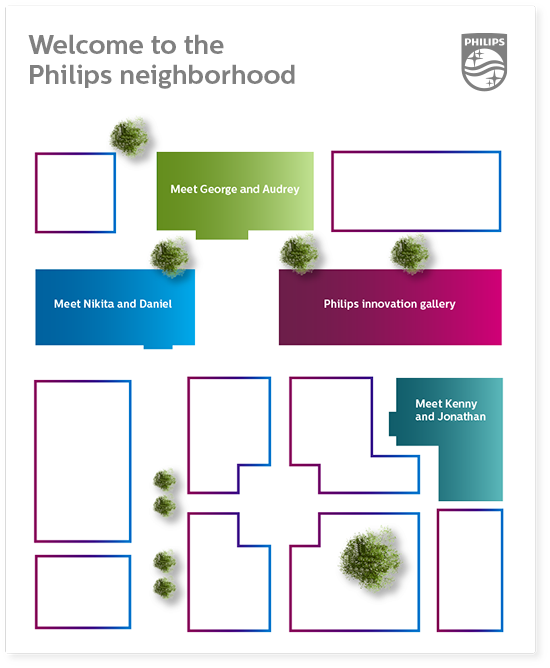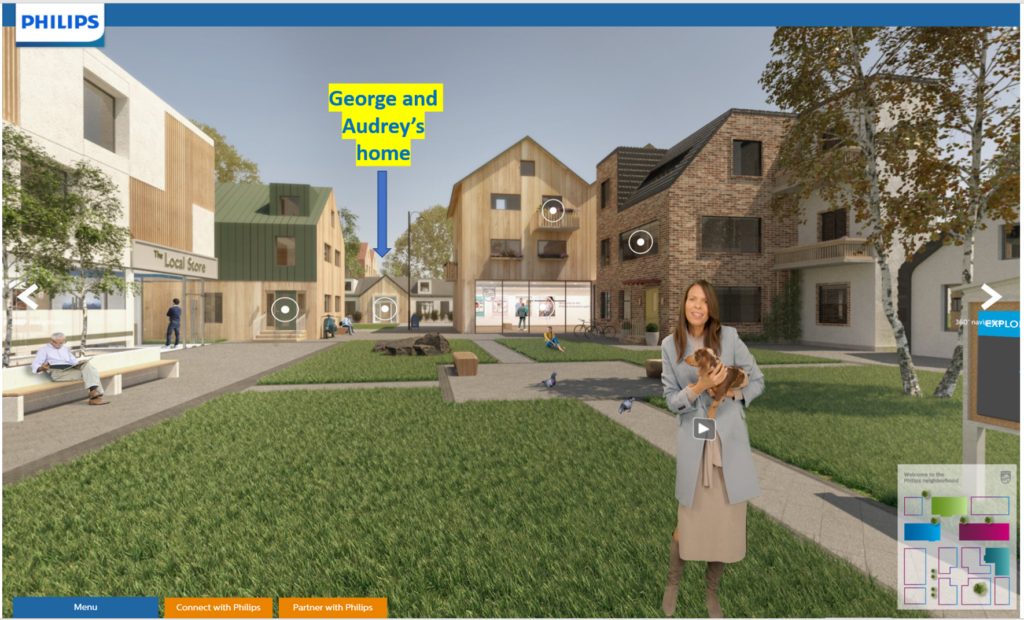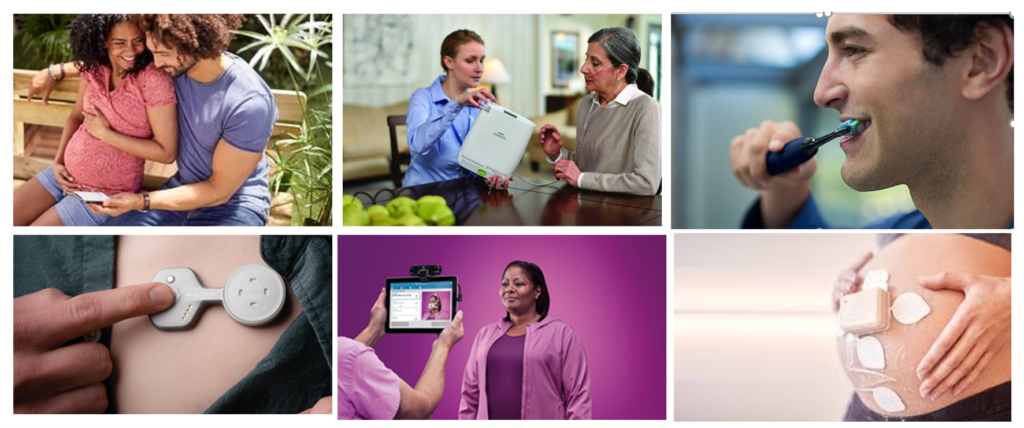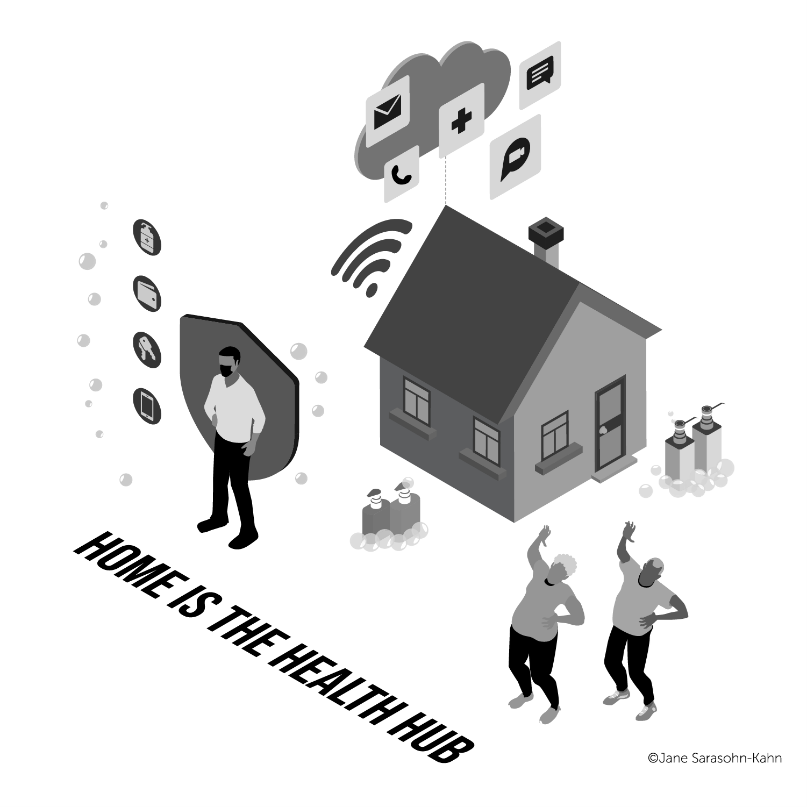At the start of CES 2021, I had the opportunity to catch up with Karsten Russell-Wood, Portfolio Marketing Leader, Post Acute & Home, Connected Care at Philips. We brainstormed just as CES 2021 was going to “open,” virtually, for the consumer electronics conference’s first all-virtual meeting.
 Philips, a longtime major exhibitor at CES, created an entirely new online experience for the CES attendees – a sort of virtual gallery of different exhibits that are accessed from a single point in a “room” with various entry points. One of the company’s key messages for CES 2021 was health care delivered outside of hospital settings – especially in a person’s home across the continuum-of-care — for virtual medical care, health promotion, and overall well-being.
Philips, a longtime major exhibitor at CES, created an entirely new online experience for the CES attendees – a sort of virtual gallery of different exhibits that are accessed from a single point in a “room” with various entry points. One of the company’s key messages for CES 2021 was health care delivered outside of hospital settings – especially in a person’s home across the continuum-of-care — for virtual medical care, health promotion, and overall well-being.
As Deeptha Khanna, Philips’ Chief Business Leader for Personal Health, said in the company’s virtual press conference, “We have [also] witnessed the reinvention of our homes as a core element of the healthcare pathway, with telehealth, virtual and remote care technologies as the key drivers for change during COVID-19. And these changes are here to stay.”
With that premise, Karsten took me on a “visit” to a neighborhood where we meet 3 different householders to see how digital health can support a health citizen’s personal demands and objectives. You can visit the neighborhood here — CES2021 (v-liveexperience.com) – then click on “Explore” where Maureen and her adorable dog will welcome you and explain how to navigate your journey.
You’ll see a map (shown above) which points you to three health-connected households as well as the Philips Innovation Gallery (the purple rectangle on the map).
As we toured the three homes, one macro theme emerged: how for each family unit, different areas of the house can embed with different health-making opportunities. You can explore various digital tech innovations that go in different “rooms” by clicking on the Philips Innovation Gallery. There, you can go into different “portraits” behind which are details of products and services that meet various health citizen demands for self-care, such as medical functions like remote monitoring for patients discharged home from hospital (say, relaxing in the living room), oral care for tooth-brushing and accessing professionals through a tele-dentistry service (the bathroom), and fetal monitoring and baby-care apps for the nursery.
We met up with three householders:
- Nikita and Daniel, a young couple expecting a baby;
- Kenny and Jonathan, two men working from home in the COVID-19 era and working on better health habits and one managing sleep apnea; and,
- George and Audrey, an older couple representing the healthy aging consumer segment with George discharged home following a cardiac procedure.
 Take George and Audrey. See that their home is a one-story design in the connected health neighborhood, a good choice for a couple seeking to age well in their home without stairs. Each of them is dealing with different medical conditions: George has been diagnosed with heart failure and Dorothy is managing COPD. She is George’s caregiver, and also has to care for her own challenging respiratory condition. This is an important nuance in the story of an aging couple, an issue that has exacerbated and been brought to sharper focus during the pandemic.
Take George and Audrey. See that their home is a one-story design in the connected health neighborhood, a good choice for a couple seeking to age well in their home without stairs. Each of them is dealing with different medical conditions: George has been diagnosed with heart failure and Dorothy is managing COPD. She is George’s caregiver, and also has to care for her own challenging respiratory condition. This is an important nuance in the story of an aging couple, an issue that has exacerbated and been brought to sharper focus during the pandemic.
We meet George and Audrey in their open kitchen-dining room space, with George finishing up a conversation with his cardiologist via a tablet. George tells us about being discharged home after dealing with heart failure in the hospital. He is wearing his BioIntelliSense “BioSticker” which communicates vital sign metrics, used along with Philips remote patient monitoring program.
Audrey tells us about her ability to manage COPD from home using Philips SimplyGo Mini oxygen concentrator, helping her “stay healthy and connected” in her words. Navigate the 360° around the room, and you’ll see Audrey’s tablet sitting on a coffee table which has her patient engagement app connecting her to her care team. “This whole telehealth option is definitely for me, even post-COVID” she says. Continue your search around the room, and click on the TV to learn more about the BioIntelliSense BioSticker on the TV set.
Now, let’s visit with Nikita and Daniel. “Having a baby during the pandemic is not without its challenges,” Nikita confesses, explaining how the midwife comes to the house for visits. She uses the Avalon fetal monitor which helps them avoid a trip to the doctor’s office. Nikita and Daniel use the mobile app Pregnancy+, learning about the pre-natal process and new-parent skills through their pregnancy journey. The Avalon app enables them to track the ultrasound history, and eventually they will take advantage of the Avent breast pump. Nikita’s OB has also recommended special attention to her oral health care, and so their bathroom now features a Sonicare Prestige 9900 connected toothbrush (more on that below in Jonathan and Kenny’s self-care story).
Daniel, the dad-to-be, explores the nursery discussing the Pregnancy+ and Baby+ apps, explaining how the COVID-19 pandemic has concerned them, compelling them to get as much support from home on their pregnancy versus heading out to the OB’s office.
The Lumify tele-ultrasound technology is especially useful in this risk-managing time as Nikita has been diagnosed with high blood pressure – a common co-morbidity for pregnant women. The Lumify transducer plugs into the midwife’s tablet and captures a clinically fine image to collaborate in real-time with a doctor at another location. This has utility for both patient and provider.
[For more on Philips’ approach to pregnancy and women’s health in the COVID-19 pandemic, check out this link].
 Our third virtual home visit introduces us to Jonathan and Kenny, both working from home in the pandemic. In making this transition to #WorkFromHome, Kenny notes that now, the couple has, “time to do more things for us.”
Our third virtual home visit introduces us to Jonathan and Kenny, both working from home in the pandemic. In making this transition to #WorkFromHome, Kenny notes that now, the couple has, “time to do more things for us.”
Some of those things have to do with self-care for health. Since COVID-19 emerged, Jonathan discovered that he has sleep apnea. After taking a sleep study at home, he explains, he benefited from the experience in getting fitted via Respironics Mask Selector 3D – a touch-free scan of his face snapping 150 images in 20 seconds to collect his main features that, together, help design a personalized mask fit just for him.
What enables this personalization is Philips’/Respironics’ many years in the sleep business, having captured thousands of facial data points – which as Philips says are stored in a “Facial Point Cloud” – informing the intelligence that underpins the customized fit of Jonathan’s mask.
Jonathan also uses the DreamMapper sleep app that couples to the connected CPAP mask, allowing him to track his sleep trends over time.
I noted to Karsten this scenario reminded me of the Warby Parker approach to getting fitted for new eyeglass frames in a touch-free environment. Welcome to contact-less health, which should persist long after the pandemic has calmed.
While Jonathan has been focusing on sleep-health in the pandemic, Kenny is all about dental care and discusses the Philips 9900 Prestige Power Toothbrush which as a connected device, also has an app. It’s “like having your own [dental] coach,” Kenny explains, having missed effective brushing in one sector of his mouth. His employer offers a dental benefit which participates in the Philips Sonicare dental plus program. Kenny also points out that the Sonicare portfolio has a tele-dentistry service that can connect him to a dental professional where he need to find a new provider or be traveling out-of-town away from his usual dentist. As an aside, I really want the guys’ bathroom set-up; great aesthetic sensibilities, those designers at Philips!
These three scenarios, and Philips’ usual work-flow, involves a lot of design research, which I’ve discussed previously here on Health Populi. In particular, I learned so much from a conversation during CES 2019 with Sean Carney, Philips’ Chief Design Officer.
During COVID, Philips quickly pivoted both in terms of re-deploying its design and manufacturing capabilities for building ventilators and advising hospital clients in reallocating inpatient resources toward the pandemic needs in 2020. At the same time, the company continued ongoing research, learning from both patients and providers in the Age of COVID and how needs and concerns were changing in real-time, for safety, convenience, risk-management, and clinicians’ requirements.
Karsten especially called out “deeply psychological behavioral concerns for safety and security,” which informed and inspired Philips’ commitment to developing tools and services that helped serve people to receive care they wanted at/from home. The company’s long-term research into healthy aging at home in particular guided solutions for older people in the pandemic, like George and Audrey.
Philips learned that throughout our COVID Year of 2020, health care providers often preferred to keep patients at home, some as part of Medicare payment innovations and others moving hospital care to the home as part of evolving clinical protocols and the growing Internet of Things for health – many of which were unveiled at CES 2021.
Philips’ virtual CES 2021 home page captures the company’s view on how our pandemic year is “transforming how and where people receive care forever.” My personal tour, thanks to Karsten and the Philips team, bolsters my own forecast that our homes, neighborhoods and local communities will be where our health and health care will be made and delivered in and beyond the public health crisis.
Health Populi’s Hot Points: The six photos shown above are but a few examples displayed and explained in the Philips Innovation Gallery. Taken together, these and other digital health innovations in the Gallery will give you a sense of the promise of our evolving homes for health/care.
 In the pandemic, most people experienced their own personal kind of digital transformation; like Kenny and Jonathan, many people were compelled to work from home, or to attend school from home. People the world over learned to cook and/or bake, taking on new life-flows and learning how to re-purpose a spare room or the corner of a family shared space into a workout space. Our homes, too, underwent digital transformation as long as we had access to a broadband connection.
In the pandemic, most people experienced their own personal kind of digital transformation; like Kenny and Jonathan, many people were compelled to work from home, or to attend school from home. People the world over learned to cook and/or bake, taking on new life-flows and learning how to re-purpose a spare room or the corner of a family shared space into a workout space. Our homes, too, underwent digital transformation as long as we had access to a broadband connection.
My view is that 2020 was also the year people digitally transformed as/when they could, and learned the values of health citizenship: self-care, hygiene, safety, risk-management, and political engagement for health and community well-being. More people as health citizens also learned about living in an ecosystem beyond one’s hyperlocal community, where a virus emerging in one part of the world thousands of miles away can impact – and infect – us living on the other side of the world.
Philips, too, understands that the company operates within a health ecosystem, not able to do “everything” themselves. That’s why the company has partnered with the maker of the BioSticker; with Delta Dental insurance for oral care services; and recently invested in the Babyscripts program that bolsters pregnant women’s’ self-care at home through digital health tools and shared decision making with OBGYNs.
“Transactional business models aren’t the way of the future,” Karsten said. Indeed, it will continue to take a village of relationships and mutual benefits to help us re-imagine and re-build our health systems for resilience and sustainability as we get through and past the pandemic.
The post The Digital Transformation of Home for Health – Brainstorming with Karsten Russell-Wood of Philips appeared first on HealthPopuli.com.
The Digital Transformation of Home for Health – Brainstorming with Karsten Russell-Wood of Philips posted first on https://carilloncitydental.blogspot.com
No comments:
Post a Comment